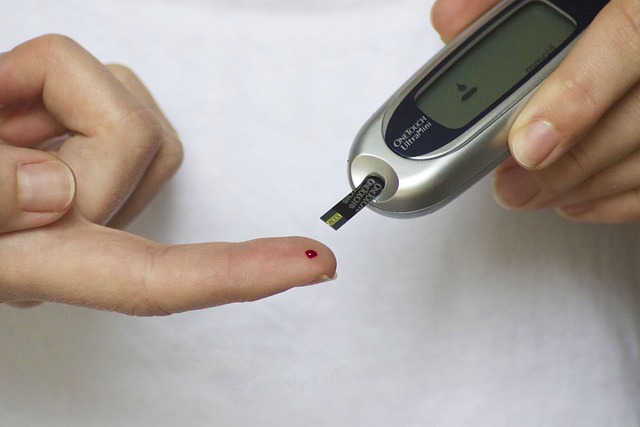Semaglutide is a groundbreaking GLP-1 receptor agonist that revolutionizes diabetes management. By mimicking natural GLP-1 hormone effects, it safely and effectively lowers blood sugar levels with once-weekly administration, reducing HbA1c and cardiovascular risks. Moreover, semaglutide promotes weight loss, enhancing patient quality of life. Clinical trials highlight its success in type 2 diabetes (T2D) and weight management, leading to global regulatory approval. Healthcare providers view it as a game-changer, offering improved glycemic control, mental clarity, and productivity for patients. However, implementing semaglutide requires careful patient selection and regular follow-ups. Expanding access and addressing cost challenges are crucial for maximizing its benefits on a global scale.
“Semaglutide emerges as a game-changer in diabetes management, offering new hope for healthcare providers seeking improved patient outcomes. This review delves into the multifaceted role of semaglutide in treating diabetes, exploring its mechanism of action and significant benefits. We analyze clinical trials providing compelling evidence for its efficacy, while patient perspectives highlight its impact on enhancing quality of life. Additionally, we discuss practical integration strategies and future directions aimed at expanding access to this promising semaglutide diabetes treatment.”
Semaglutide: A New Horizon in Diabetes Management

Semaglutide represents a significant advancement in diabetes management, offering healthcare providers a powerful tool to help patients achieve better glycemic control. As a novel medication, it stands out due to its unique mechanism of action, mimicking the effects of the natural hormone GLP-1. This approach not only improves insulin secretion but also suppresses glucagon release, leading to reduced blood sugar levels. With its once-weekly administration, semaglutide provides convenience and flexibility for patients, a key aspect in encouraging adherence to treatment plans.
The benefits extend beyond improved glycemic management. Clinical trials have demonstrated semaglutide’s capability to promote weight loss, making it a comprehensive solution for many diabetes patients who struggle with obesity. This multi-faceted approach positions semaglutide as a game-changer in the diabetes treatment landscape, promising enhanced patient quality of life and potential long-term health benefits.
Understanding Semaglutide: Mechanism of Action and Benefits

Semaglutide, a glucagon-like peptide-1 (GLP-1) receptor agonist, has emerged as a potent tool in the diabetes treatment arsenal. Its mechanism of action involves mimicking the natural effects of GLP-1, a hormone produced in the gut that plays a crucial role in regulating blood sugar levels. By binding to GLP-1 receptors, semaglutide stimulates insulin secretion in a glucose-dependent manner, helping to lower blood sugars. This targeted approach offers several benefits for patients with type 2 diabetes.
One of its key advantages is the ability to provide sustained glycemic control, often leading to significant reductions in HbA1c levels. Additionally, semaglutide promotes weight loss, making it a valuable option for managing obesity-related conditions. Its once-weekly administration and reduced risk of hypoglycemia compared to some other diabetes medications further enhance its appeal from the healthcare provider’s perspective.
Clinical Trials: Evidence Supporting Semaglutide for Diabetes

Clinical trials have played a pivotal role in establishing semaglutide as a potent and effective diabetes treatment. These studies, conducted with rigor and precision, have provided compelling evidence for its use in managing both type 2 diabetes (T2D) and weight management. The results from numerous phase 3 clinical trials demonstrate semaglutide’s ability to significantly reduce HbA1c levels, a key marker of long-term glycemic control, compared to placebo or other standard treatments.
Moreover, these trials have shown remarkable improvements in patient outcomes, including reduced risk of hypoglycemia and cardiovascular events. The positive findings have led to the approval of semaglutide by regulatory bodies worldwide for various diabetes indications. This evidence-based approach ensures healthcare providers can confidently prescribe semaglutide as a reliable and safe option for their diabetic patients.
Patient Perspectives: Improving Quality of Life with Semaglutide

For patients living with diabetes, managing their condition can be a constant struggle. The daily routines and lifestyle adjustments required to maintain blood sugar levels often impact their overall quality of life. However, healthcare provider perspectives on semaglutide for diabetes offer a glimmer of hope. Semaglutide, a medication that mimics a natural hormone, has been shown to not only effectively lower blood sugar but also significantly improve patient experiences.
Many patients report increased energy levels and reduced hunger after incorporating semaglutide into their diabetes management regimen. These improvements translate into better mental clarity, higher productivity, and an overall enhanced sense of well-being. Moreover, semaglutide’s ability to promote weight loss has been a significant advantage for many, helping them to manage other comorbid conditions and improve their overall health. Patient perspectives on semaglutide diabetes treatment are overwhelmingly positive, highlighting its potential to transform the lives of those living with this chronic condition.
Integrating Semaglutide into Healthcare Practices

The integration of semaglutide, a novel drug for diabetes treatment, into healthcare practices offers promising prospects for managing this chronic condition. Healthcare providers are increasingly recognizing its potential as a game-changer in glycemic control. Semaglutide’s unique mechanism of action mimics the effects of GLP-1, a natural hormone that enhances insulin secretion and suppresses glucagon release. This approach not only improves blood sugar levels but also aids in weight management, addressing a common challenge in diabetes care.
Implementing semaglutide into routine clinical practice involves careful consideration. Providers must be well-versed in the drug’s administration, monitoring guidelines, and potential side effects. Patient selection is crucial; those with type 2 diabetes who meet specific criteria are ideal candidates. Regular follow-ups are essential to assess the treatment’s effectiveness and adjust dosage accordingly. By embracing this innovative therapy, healthcare providers can offer patients a more comprehensive and potentially life-changing approach to managing their diabetes.
Future Directions: Expanding Access and Addressing Challenges

As healthcare providers, we stand at an exciting crossroads with semaglutide as a game-changer in diabetes management. The future holds immense potential for expanding access to this innovative semaglutide diabetes treatment, particularly in diverse patient populations and underserved communities. By bridging the gap between specialized care and community settings, we can ensure that more individuals benefit from its remarkable efficacy in reducing HbA1c levels.
Addressing challenges such as cost implications and patient adherence will be crucial. Continued research and collaboration are vital to developing cost-effective strategies and identifying solutions to enhance medication adherence, ultimately maximizing the therapeutic benefits of semaglutide for diabetes management on a global scale.
